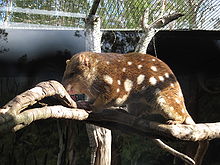- Western quoll
-
Western quoll[1] 
At Billabong Koala and Wildlife Park, New South Wales, Australia Conservation status Scientific classification Kingdom: Animalia Phylum: Chordata Class: Mammalia Infraclass: Marsupialia Order: Dasyuromorphia Family: Dasyuridae Genus: Dasyurus Species: D. geoffroii Binomial name Dasyurus geoffroii
Gould, 1841Western Quoll range The western quoll (Dasyurus geoffroii), also known as the chuditch or western native cat, is a medium sized predator and like its eastern and northern relatives, has a white-spotted brown coat and a long tail. It is most closely related to the eastern quoll from which it differs in possessing a first toe on the hindfoot and a darker tail. It is classed as a vulnerable Australian dasyuromorph, whose distribution is now confined to south-western Western Australia.
Contents
Description
The western quoll is a medium-sized quoll that is coloured a rufous brown on its upperparts with white spots and a creamy white below. It has five toes on its hindfoot and granular pads.[3]
The western quoll is a solitary, nocturnal predator which is mostly terrestrial, although it does climb trees. It has a diet of small vertebrates, carrion, arthropods and freshwater crayfish, among other things. The breeding season is from April-July.[4]
The head and body average about 330 mm in length, with the tail averaging another 280mm. An individual can weigh up to 2 kg with males being slightly heavier.[5]
Behaviour
The western quoll moves swiftly on the ground, climbs efficiently and may dig or occupy existing holes in the ground. Activity is greatest around dusk and dawn with the animal being crepuscular.
Habitat
The western quoll was formerly found throughout most of inland Australia, reaching areas of Queensland, New South Wales and Victoria. It is now restricted to the south-western corner of Western Australia, where it inhabits wet and dry sclerophyll forests and mallee.[4]
Taxonomy
The western quoll was described by John Gould in 1841, when it was still widespread throughout the continent. Its species name, geoffroii, refers to the prominent French naturalist Étienne Geoffroy Saint-Hilaire, who named the genus Dasyurus in 1796. The species has sometimes been placed in the genus Dasyurinus.[3]
The western quoll is a member of the family Dasyuridae and is most closely related to the Bronze Quoll (Dasyurus spartacus), a recently described species from New Guinea that was for some time believed to be an outlying population of the western quoll.
References
- ^ Groves, C. (2005). Wilson, D. E., & Reeder, D. M, eds. ed. Mammal Species of the World (3rd ed.). Baltimore: Johns Hopkins University Press. pp. 25. OCLC 62265494. ISBN 0-801-88221-4. http://www.bucknell.edu/msw3.
- ^ Morris, K., Burbidge, A. & Hamilton, S. (2008). Dasyurus geoffroii. In: IUCN 2008. IUCN Red List of Threatened Species. Downloaded on 28 December 2008. Database entry includes justification for why this species is listed as near threatened
- ^ a b Serena, M.; Soderquist, T. (1995). "Western Quoll". In Strahan, Ronald. The Mammals of Australia. Reed Books. pp. 62–64.
- ^ a b Menkhorst, Peter (2001). A Field Guide to the Mammals of Australia. Oxford University Press. p. 48.
- ^ "Chudditch (Western Quoll) (Dasyurus geoffroyi)". australianfauna.com. http://www.australianfauna.com/chudditch.php. Retrieved 2008-03-13.
Categories:- IUCN Red List near threatened species
- Dasyuromorphs
- Extinct mammals of South Australia
- Vulnerable fauna of Australia
- Mammals of Western Australia
Wikimedia Foundation. 2010.


